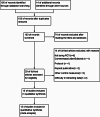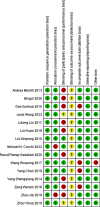The role of esmolol in sepsis: a meta-analysis based on randomized controlled trials
- PMID: 39266951
- PMCID: PMC11391746
- DOI: 10.1186/s12871-024-02714-3
The role of esmolol in sepsis: a meta-analysis based on randomized controlled trials
Abstract
Background: Sepsis is associated with a high incidence and mortality and poses a significant challenge to the treatment. Although esmolol has shown promise in sepsis treatment, its efficacy and safety remain contentious. This meta-analysis aims to clarify the role of esmolol in sepsis management.
Methods: PubMed, Embase, Web of Science, Cochrane library, clinicaltrials.gov and the Chinese Clinical Trial Registry were searched and references of relevant reviews and meta-analysis were also screened for appropriate studies. Keywords and free words of 'sepsis', 'esmolol' and 'randomized controlled trials' were used for search. Meta-analysis was performed using RevMan 5.3 software.
Results: Fifteen studies involving 1100 patients were included. Compared with the control group, patients receiving esmolol exhibited significantly decreased 28-day mortality (RR, 0.69; 95% CI, 0.60 to 0.81; P < 0.0001), heart rate (HR) (SMD, -1.15; 95% CI, -1.34 to -0.96; P < 0.0001), cardiac troponin I levels (cTnI) (SMD, -0.88; 95% CI, -1.13 to -0.64; P < 0.0001), length of intensive care unit (ICU) stay (SMD, -0.46; 95% CI, -0.62 to -0.3; P < 0.0001) and duration of mechanical ventilation (SMD, -0.28; 95% CI, -0.48 to -0.09; P = 0.004) and significantly increased central venous oxygen saturation (ScvO2) (SMD, 0.66; 95% CI, 0.44 to 0.88; P < 0.0001).While, esmolol had no significant influence on norepinephrine dosage (SMD, 0.08; 95% CI, -0.13 to 0.29; P = 0.46), mean arterial pressure (MAP) (SMD, 0.17; 95% CI, -0.07 to 0.4; P = 0.16), central venous pressure (CVP) (SMD, 0.16; 95% CI, -0.04 to 0.35; P = 0.11) and left ventricular ejection fraction (LVEF) (SMD, 0.21; 95% CI, -2.9 to 0.7; P = 0.41).
Conclusion: Esmolol reduces 28-day mortality, length of ICU stay and duration of mechanical ventilation in sepsis patients. Furthermore, esmolol improves oxygen metabolism, mitigates myocardial injury and decreases heart rate without significantly affecting hemodynamic parameters.
Trial registration: This study was registered on the PROSPERO website (registration number: CRD42023484884).
Keywords: Esmolol; Meta analysis; Randomized controlled trials; Sepsis; Septic shock.
© 2024. The Author(s).
Conflict of interest statement
The authors declare no competing interests.
Figures






Similar articles
-
[Esmolol improves clinical outcome and tissue oxygen metabolism in patients with septic shock through controlling heart rate].Zhonghua Wei Zhong Bing Ji Jiu Yi Xue. 2015 Sep;27(9):759-63. Zhonghua Wei Zhong Bing Ji Jiu Yi Xue. 2015. PMID: 26955704 Clinical Trial. Chinese.
-
Benefits of esmolol in adults with sepsis and septic shock: An updated meta-analysis of randomized controlled trials.Medicine (Baltimore). 2022 Jul 8;101(27):e29820. doi: 10.1097/MD.0000000000029820. Medicine (Baltimore). 2022. PMID: 35801730 Free PMC article.
-
VERY EARLY USE OF ESMOLOL IN HYPERKINETIC SEPTIC SHOCK PATIENTS WITH PERSISTENT TACHYCARDIA: A RANDOMIZED CONTROLLED PILOT STUDY.Shock. 2025 Jun 1;63(6):870-877. doi: 10.1097/SHK.0000000000002576. Epub 2025 Mar 3. Shock. 2025. PMID: 40101954 Clinical Trial.
-
Prognosis of β-adrenergic blockade therapy on septic shock and sepsis: A systematic review and meta-analysis of randomized controlled studies.Cytokine. 2020 Feb;126:154916. doi: 10.1016/j.cyto.2019.154916. Epub 2019 Nov 19. Cytokine. 2020. PMID: 31756644
-
The Efficacy and Safety of Esmolol for Septic Shock: A Systematic Review and Meta-analysis of Randomized Controlled Trials.Front Pharmacol. 2021 Jun 1;12:682232. doi: 10.3389/fphar.2021.682232. eCollection 2021. Front Pharmacol. 2021. PMID: 34140891 Free PMC article. Review.
Cited by
-
Esmolol improves sepsis outcomes through cardiovascular and immune modulation.Front Pharmacol. 2025 May 12;16:1498227. doi: 10.3389/fphar.2025.1498227. eCollection 2025. Front Pharmacol. 2025. PMID: 40421209 Free PMC article.
References
Publication types
MeSH terms
Substances
LinkOut - more resources
Full Text Sources
Medical
Research Materials

